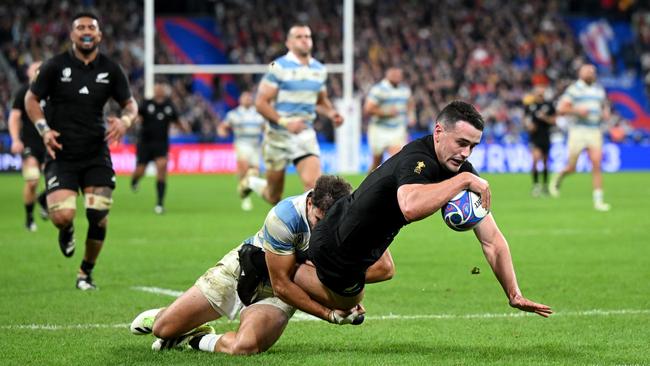All Blacks flyer can stamp himself as an all-time great
Will Jordan is in esteemed company. The New Zealand wing’s eight-try tally at this tournament puts him alongside Jonah Lomu, Bryan Habana and Julian Savea.

Will Jordan is in esteemed company. The New Zealand wing’s eight-try tally at this tournament puts him alongside Jonah Lomu, Bryan Habana and Julian Savea as the only players to have scored that number in an individual World Cup. On Sunday morning the elegant, upright-running Jordan has the opportunity to eclipse the trio and stand alone – unless Henry Arundell crosses for a quartet of tries in Saturday morning’ bronze-medal match – making a little bit of World Cup history.
The Crusaders wing doesn’t have the raw power of the legendary Lomu or the sheer speed of Habana but he has a knack like no other for finding his way over the tryline. The former Japan international Daisuke Ohata, with 69 tries in 58 matches, has a superior ratio of tries to Tests but the vast majority of his were against the likes of Korea and Hong Kong. When it comes to the serious stuff, Jordan is in a league of his own.
No other international with a reasonable number of caps has a strike rate of better than a try per Test match. Jordan’s hat-trick in the World Cup semi-final against Argentina not only drew him level with three World Cup legends but took his tally to 31 tries in 30 Tests. Of his modern-day rivals, Damian Penaud’s rate of 35 tries from 47 Tests is next best.
Only three top-tier internationals have a superior strike rate to Penaud – and they are all Kiwis. Doug Howlett and Christian Cullen both averaged 0.79 tries a game, with Savea the second-most deadly finisher of them all with 46 tries from 54 matches (0.85 per game). That is a phenomenal effort but Jordan is out on his own when it comes to that tries-per-game barometer.
The fact there are so many All Blacks on the all-time tryscoring list is testament to their attacking ability and instinct. But Jordan’s record is even more impressive because he has played through one of the poorest periods in their history, a blot on the Kiwi rugby landscape when the aura escaped them and opponents beat them regularly.
He has also missed eight months with what was described as a migraine-related condition, the effects being dizziness and vertigo. Now, on the verge of New Zealand’s bid to beat South Africa to four World Cup triumphs, it is the opposition being run dizzy. After Jordan’s semi-final hat-trick, his Argentinian opponent, Newcastle Falcons’ Mateo Carreras, said: “He’s everywhere on the pitch.”
Jordan wears the No 14 right-wing shirt but has been encouraged to roam the field. His favourite position is fullback but in the interest of balance he remains out wide, with Beauden Barrett taking the vital role of second playmaker to Richie Mo’unga. Barrett sees the scenario as a fly half, Jordan as a predator. His work rate is spectacular but it is the capacity to spot space that marks him as statistically the greatest finisher in the history of the international game. Nobody seems to ease through a defensive gap quite like Jordan. The best attackers see the space before the defence realises it exists.
Back in 2021, I saw him score a try in Cardiff. He countered his way through the slightest of zigzags in the Welsh defensive line. Then, one-on-one and close to where the press box is located, he chipped a ball with the outside of his right foot. It hit the ground and spun perfectly back into his waiting hands. What do they say? You make your own luck.
Well, maybe not. Maybe there was more than a dollop of good fortune to his chip and chase. In the semi-final he took an inside pass from Julian’s brother, Ardie, and glided to the last covering Puma. He chipped the tackler, caught the ball without breaking stride and touched down. The replay showed, quite clearly, the same technique; the ball placement on the outside of the right foot. Who can tell how long he has worked on this skill, which he alone seems to possess?
He combines the purest class with a commitment to his game. This column is in praise of his tryscoring prowess but he offers so much more. When he floats around in midfield, waiting for the space to reveal itself, he’s almost as likely to play the role of assistant as scorer. His 20-metre left-handed pass to Jordie Barrett, waiting on the right touchline to score against Argentina, was a pass of the purest quality. Barrett didn’t need to break stride.
Jordan wasn’t necessarily born to be a great rugby player. His craft is a result of the rugby industry as well as innate intelligence, which has long been the hallmark of New Zealand. Cheslin Kolbe, a veritable genius in his own right, has a more dramatic change of pace and turn of direction but the arcing New Zealander sees space quicker than anyone.
Anyone can run around with great energy and be about as useful as a headless chicken. Conversely, you can try to make every metre running in support, or with the ball, into something positive for your side. Jordan epitomises the rugby nous of his nation. Statistically, he is the finest finisher in the Test-match arena. Tomorrow he has a chance to reiterate that he is more than the beneficiary of his All Black colleagues. He finishes like no other, catches kicks like a full back and does everything else with a sense of purpose. Lomu, Habana and Savea? Jordan may just be better than all of them.
The Times



To join the conversation, please log in. Don't have an account? Register
Join the conversation, you are commenting as Logout